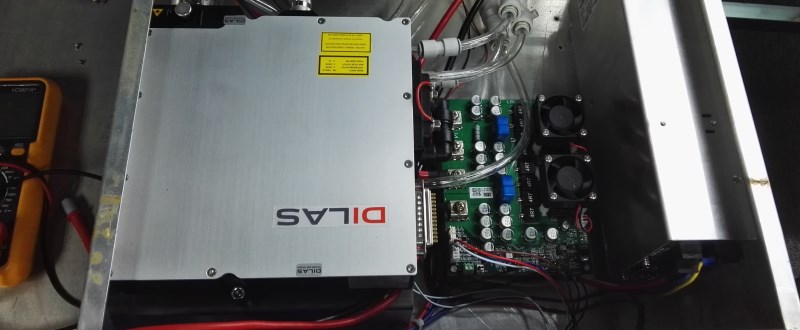Condition:New
Type:Logic ICs
DILAS/COHERENT high-power laser diode dedicated driver board (laser power board), output efficiency>97%.
The board has no special heat dissipation requirements. The maximum output is 2kW.

Product information
Product name: LD driver board
Product number:
LDDC-xxAyyV-MA
xx: Rated output current, which is the current corresponding to the highest analog input
Optional values: 10-60
yy: supply voltage
Optional values: 24V, 36V, 48V
For example: LDDC-45A24V-MA
Features
Load voltage, the highest support rated 44V LD (48V power supply)
Load current up to 60A
Load voltage adaptive
High speed, <1ms rising and falling edge
High efficiency, air-cooled
Two analog channels are optional (internal and external control, one of which is a slow interface, which can be connected to analog or potentiometer)
The channel is switched to a high-speed analog switch, which can realize the modulation function
Compact design, easy to integrate
Recommended Applications
DILAS Multi-Bar series products
COHERENT similar products
Diode Lasers
Fiber Lasers
CW or Pulsed Applications Various products that require constant current output, such as semiconductor laser testing, LED light-emitting diode testing, etc.
Welding, cutting, heating, product testing and other applications
Parameters Table
Load current: 60A Max
Load voltage: 34.0V Max, 1V less than the supply voltage
Rise/fall time: <1ms
Efficiency:> 97%
Input power supply voltage: 24V DC (limit range: 22-25V), another 32V/36V version
Current analog input: 0-5V corresponds to 0-maximum current, or user specified
Current feedback output: 0-2.5V corresponds to 0-maximum current, or user specified
Storage temperature: -40-+60°
Working temperature: -10-+45°
Working humidity: 0-95%
Shape: 160mm*120mm
Interface definition
1. PVDD GND DC power input /φ5 high current terminal
2. AN2/POT, the second channel analog input terminal, which can be connected to a potentiometer or analog quantity /2510-3P socket
3. CHSW channel (internal and external control) selection/2510-2P socket, if not connected, the analog input of CTL interface will be used by default
4. CTL control terminal/2510-6P socket
5. SHT lock interface /2510-2P socket
2pin is short-circuited for enabling, disconnected for disabling.
6. A, K load interface /φ5 high current terminal block
A: Connect the positive pole of the load LD
K: Connect the negative pole of the load LD
Different application configurations
1. For applications that only need one analog quantity to directly control the output current of the driver board, at this time, only the CTL interface can be used to control the driver board, and no signal is connected to the AN2/POT and CHSW interfaces.

2 For applications that require internal and external control, such as a power box, both local signals and external analog signal input ports are required. The local signal is generally provided by a potentiometer or generated by a local single-chip microcomputer, while the external control signal is provided by the user of the cabinet. At this time, Ic of CTL can be used to connect external analog signals, AN2/POT can be directly connected to a 10k (1k-100k is acceptable) potentiometer, or a local analog signal generated by Ic2 microcontroller, and then use CHSW SW to switch internal control and external control. Can.

3 For applications that require fast modulation current (such as the power switch of a fiber laser), you can use the Ic of CTL to input the operating current signal, the Ic2 of AN2/POT to input the threshold current signal, and then directly use the TTL signal to output the SW of CHSW to modulate the current. Of course, it is also possible to directly modulate the analog quantity, that is, only use the analog quantity whose Ic input changes rapidly.

Note that when modulating, it is generally not adjusted between 0A and working current, but the threshold to working current. 0A is not good for laser diodes first, because there is no maintained threshold current, thermal shock will be greater, which is not good for laser diodes. Secondly, the debugging performance is also very poor, which will not only lengthen the current rise time, but also generate excess response time, thereby reducing the modulation speed.

